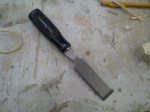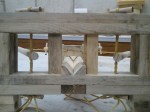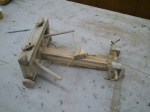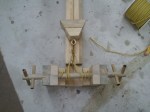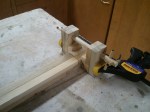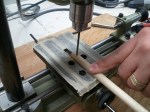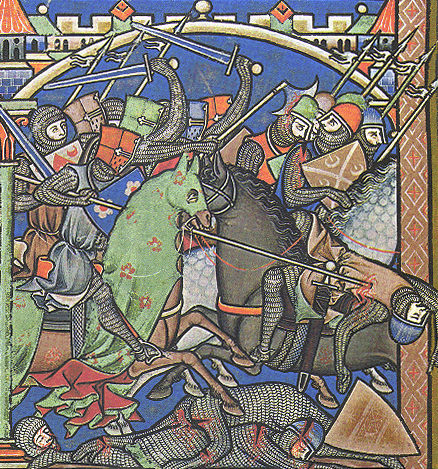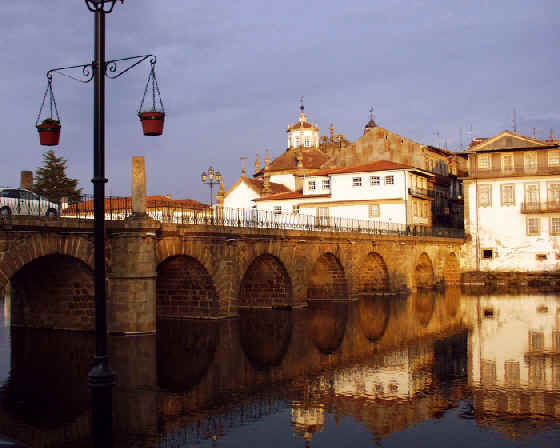In 107 BC, General Gaius Marius instituted a group of military reforms, such as the formation of a standing army, the standardization of legionary training and equipment, and the reorganization of the legions. This final reform included reducing the baggage train by having each legionary carry their own supplies and a few days worth of rations (Wikipedia contributors, “Marian reforms”). Matyszak put the average weight of a marching pack at a bit less than 60 pounds (66).

Roman soldiers with marching packs. From the cast of Trajan's column in the Victoria and Albert museum, London. Picture by "Gaius Cornelius". Via http://en.wikipedia.org/wiki/File:Roman_soldiers_with_marching_packs_01.JPG.
Instead of being directly carried like the modern backpack, the marching pack was strapped to a cross-shaped pole called a furca (Matyszak, 67). I created my furca out of wooden dowels based on measurements from the Legio XX Online Handbook: a 4 foot tall wooden pole with a 20 inch crossbar secured about 3 inches from the top of the pole (“Marching Pack”). It is unclear from the images on Trajan’s Column how the bars were secured, so the reenactment Handbook suggested bolting or nailing the crossbar to the pole, and wrapping the joint with a leather or rawhide thong. I was afraid of splitting the wood and did not have access to good quality leather or rawhide, so I secured the crossbar by wrapping it with a nylon rope that was strong enough to hold the joint.
When not being worn, the legionary’s cloak could be rolled and tied to the furca, or held in a bag attached to the crossbar. One type of cloak was the sagum, a rectangular blanket-sized cloth that would have doubled as the legionary’s bedroll (“Cloak”). Saga were used from the time of the Roman Republic to the Dominate (Bishop & Coulston, 68, 111, 184, 224). The cloaks would have been made of wool soaked in lanolin oils to keep it waterproofed (Matyszak, 67), and it would have likely been yellow brown in color because the undyed wool may have kept more of the natural oils from the wool (Sumner, “Did an Ordinary…”). I used dark red cotton corduroy to make the sagum because I found a large stretch for cheap, and because it was a heavy fabric that could approximate the weight of wool. Sagums would be pinned at the shoulder or throat with a fibula, a brooch or pin that was usually bronze, but occassionaly iron, silver, or gold (“Cloak”). For my fibula, I used a large safety pin, the design of which wasn’t far from some Roman fibulae. The dimensions I used were approximately 2.70 m (8 ft 10 in) long by 1.40 m (4 ft 7 in) wide, the measurements of an existing cloak from Israel (Sumner, “Sagum”).

The sagum was very long; the extra length could be flipped to the back to get out of the way or thrown over the head to protect against the elements.
On Trajan’s Column, a satchel is depicted with diagonal reinforcements. I used leftover corduroy from the sagum to create a non-reinforced satchel following the dimensions given by the Legio XX Handbook, about 18 inches wide by 12 inches tall (“Marching Pack”). The satchel would usually be leather, and might carry a variety of items.
The legionary’s mess kit would have consisted of his patera, a bowl about 7 inches in diameter that could be used as a bowl, cup, and cooking pot (Matyszak, 67). I used a small saucepan and covered the plastic handle with duct tape to imitate metal, though they would have been made of bronze, not silvery metals (Matyszak, 67). The Legio XX Online Handbook additionally mentioned a bronze cookpot or situla, which I represented by a duct-tape covered cookie tin (“Mess Gear”). I included a wooden stirring spoon as a stand-in for an eating spoon, which would be iron, bronze, wood, bone, or horn (“Mess Gear”).
Each soldier was supposed to carry three days worth of rations (6-8 lbs of food) and water (“Marching Pack”). Rations that would be carried on a march would include preserved food, such as bucellatum (a type of hardtack), bacon, salted meat, flour, dried lentils, etc. I sewed a small pouch for rations out of a light cotton fabric and created a drawstring using the suede lace that was too weak to hold anything else in my recreation. In this I stuffed some beef jerky and homemade bucellatum, using a recipe I found on the Legio XX reenactment site (“Mess Gear”). The way which the legionaries would carry water is much more controversial. Some iron or ceramic flasks have been found, but it is unclear if they were used as canteens (“Mess Gear”). Reenactors have tried many other solutions, from leather waterskins to animal bladders (which don’t work well because they become brittle when they dry out) (“Waterskins”). I used a modern bota bag to represent a leather waterskin.
I included mostly the basics of what a legionary would carry. They would also carry personal items such as shaving gear, a small knife, extra clothes, and so on. Vindolanda Tablet 346 is a letter (perhaps accompanying a package) telling the recipient that he was sent two pairs of socks, four pairs of sandals, and two pairs of underpants (Tab. Vindol. II 346). Though Vindolanda was a garrison, if the legionary were to go anywhere, he would have to take those extra items in his pack. The soldiers might also carry souvenirs if they traveled, or booty distributed by the commander after a battle or capturing a city (Sage, 209).

"Nice hobo pack," my friend told me. I'd advise anyone who'd like to keep their life to refrain from saying that to a real legionary.
Works Cited
Bishop, M.C. and Coulston, J.C.N. Roman Military Equipment: From the Punic Wars to the Fall of Rome. 2nd ed. Oxford: Osbow Books, 2006. Print.
“Cloak.” Legio XX Online Handbook. Legio XX: The Imperial Roman Twentieth Legion. 15 Oct. 2003. Web. 3 Apr. 2012.
“Marching Pack.” Legio XX Online Handbook. Legio XX: The Imperial Roman Twentieth Legion. 2 Dec. 2006. Web. 3 Apr. 2012.
Matyszak, Philip. Legionary: A Roman Soldier’s (Unofficial) Manual. London: Thames & Hudson, 2009. Print.
“Mess Gear.” Legio XX Online Handbook. Legio XX: The Imperial Roman Twentieth Legion. 2 Jan. 2009. Web. 3 Apr. 2012.
Sage, Michael M. The Republican Roman Army: A Sourcebook. Routledge Sourcebooks for the Ancient World. New York: Routledge, 2008. Print.
Sumner, Graham. “Did an Ordinary Roman Soldier Wear a Cape.” 12 Aug. 2006. RomanArmy.com. Web. 4 Apr. 2012.
Sumner, Graham. “Sagum.” 24 Apr. 2006. RomanArmy.com. Web. 4 Apr. 2012.
Tab. Vindol. II 346. Vindolanda Tablets Online. Script, Image and the Culture of Writing in the Ancient World, Oxford University. Web. 8 Apr. 2012.
“Waterskins.” 22 Jan. 2012. RomanArmy.com. Web. 5 Apr. 2012.
Wikipedia contributors. “Marian reforms.” Wikipedia, The Free Encyclopedia. Wikipedia, The Free Encyclopedia, 13 Apr. 2012. Web. 19 Apr. 2012.




